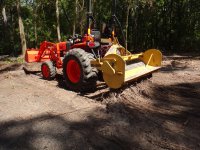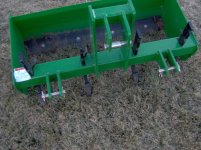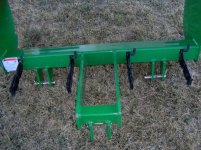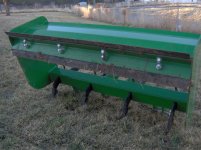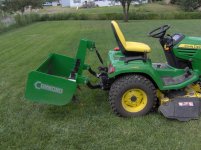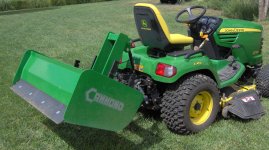there are some different styles of box blades.
front cutting edge
--some are straight sheet of metal. (cut out of a piece of plywood with a cutting edge grinded on to it for example)
--some of the cutting edges are ) "curved", to help bring cutting edge to a better angle of attack of what ever you are scrapping up
rear blade
--some have no rear blade (more so the curve cutting edges)
--some have the straight sheet of metal and/or using straight sheet of metal for both front/backwards (same blade)
--some have a 2nd cutting edge on the back for going in reverse
--some have more of a "tailgate" style 2nd cutting edge on back. were 2nd cutting edge hinges up and out of the way when going forward. and then drops down when going in reverse.
sides
--some have just a thicker metal for sides straight to riding on the ground.
--others have more of a "ski" or "sled" per say on each side. so the sides ride on the surface, while allowing just the cutting edge and/or scraficers to dig in.
--others might have additional re-enforcement between "ski" and sides. and possibly a bit more "metal" on the front corners to help reduce wear and tear.
weight
--the cheap units, for say a riding lawn mower, ATV, UTV, or like. tend to offer some sort of "concrete block" box to toss concrete blocks on unit. to help bring up total weight of unit up.
--some box blades might offer better spot to say toss a chunk of a large tree branch on, or concrete bags, or sand bags, or some 5 gallon buckets on top, to help bring up weight.
--box blades rely specifically on there own weight to dig in. and not the tractors weight.
gauge wheels
--some units offer "gauge wheels" behind the box blade. normally seen on units that are not 3PH, but rather tow/pull behind units. primary used to lift the box blade up/down.
--some units offer "gauge wheels" not for primary lifting it up and down. but rather using box blade more like a "motor grader" and help read some high/low spots, without constantly being on the lever to raise/lower the box blade.
3 point hitch connection of box blade
--pending on size, some may offer cat 1 and cat 2 3pt hitch connections (for smaller and larger tractors)
--some might be stated to fit some quick hitch setup. ((make sure to always measure first))
--some of the units might offer some extra holes at the top link connect and/or lower lift arm connections to unit. (beyond the cat 1 to cat 2 connection setup)
3 point hitch and bracing
--some units have more of a triangle approach between top link to rear of unit
--some units have additional bracing between front (just below lower lift arm connections) to rear of unit.
--some have a combination of above.
--bracing might effect how you add weight if you need to add weight to unit.
scraficier teeth.
--have seen some units before were the bolt holding the teeth on is more of a "sheer bolt" and will break and allow scraficer to swing up and out of the way.
--have seen some units were tooth fits in between to L shape tabs, or in a rectangle pipe. with a bolt. and more likely scraficier tooth will bend / warp / be destroyed if it gets hung up on something nasty.
--some teeth might be soft metal inside, with a hard coating on the outside. so once hard coating gets worn away, the inside just goes away quickly after that.
========
different styles....
--roll over box blade
--some 3PH rear blades you can get wings for them,
--some 3PH rear blades, you can get scraficer teeth for as well.
tossing in "land plain / grader scraper" = if you are talking about gravel driveways.
========
make sure you have your check chains, and sway bar/chains for 3pt hitch.
--3ph are great pulling forward, but as soon as you turn, you can destroy the 3pt hitch linkages. the check chains and sway bar/chains can help reduce some possible damage but not all of it.
going in reverse
3ph are again great pulling forward, but when you begin to reverse, you can also destroy the 3ph linkages.
generally it is always advisable to always lift any ground engaging equipment up and out of the ground before you make any turns.
========
WET and DRY
--dry dirt = concrete
--to wet = making ruts and causing additional issues
--having the soil/rock having just the right amount of wetness per say, can make things easier to work with, vs having cutting edge hip hop over the ground/rock, and/or getting the scraficer teeth to bite in.

